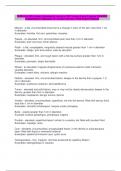NURS 612 AHA Exam | Questions & Answers (100 %Score) Latest Updated 2024/2025
Comprehensive Questions A+ Graded Answers | With Expert Solutions
Macule - a flat, circumscribed area that is a change in color of the skin; less than 1 cm
in diameter
Examples: freckles, flat nevi, petechiae, measles
Papule - an elevated, firm, circumscribed area; less than 1cm in diameter
Examples: wart (verruca), lichen planus
Patch - a flat, nonpalpable, irregularly shaped macule greater than 1 cm in diameter
Examples: vitiligo, port wine stains, cafe au lait patch
Plaque - elevated, firm, and rough lesion with a flat top surface greater than 1cm in
diameter
Examples: psoriasis, atopic dermatitis
Wheal - an elevated, irregular-shaped area of cutaneous edema; solid, transient,
variable diameter
Examples: insect bites, urticaria, allergic reaction
Nodule - elevated, firm, circumscribed lesion; deeper in the dermis than a papule; 1-2
cm in diameter
Examples: erythema nodosum, dermatofibroma
Tumor - elevated and solid lesion; may or may not be clearly demarcated; deeper in the
dermis; greater than 2cm in diameter
Examples: neoplasms, benign tumors, lipoma
Vesicle - elevated, circumscribed, superficial, not into the dermis, filled with serous fluid;
less than 1 cm in diameter
Examples: varicella (chickenpox). Herpes zoster (shingles)
Bulla - vesicle greater than 1cm in diameter
Example: bullous pemphigus, pemphigus vulgaris
Pustule - elevated, superficial lesion' similar to a vesicle, but filled with purulent fluid
Examples: impetigo, acne
Cyst - elevated, circumscribed, encapsulated lesion; in the dermis or subcutaneous
layer; filled with liquid or semisolid material
Examples: epidermal inclusion cyst, cystic acne
Telangiectasia - fine, irregular, red lines produced by capillary dilation
Examples: telangiectasia in rosacea
,Scale - heaped-up, keratinized cells; flaky skin; irregular; thick or thin; dry or oily;
variation in size
Examples: flaking of skin with seborrheic dermatitis or after a drug reaction; dry skin
Lichenification - rough, thickened epidermis secondary to persistent rubbing, itching, or
skin irritation; often involves flexor surface of the extremity
Examples: chronic atopic dermatitis
Keloid - irregularly shaped, elevated, progressively enlarging scar; grows beyond the
boundaries of the wound; caused by excessive collagen formation during healing
Examples: keloid formation after surgery
Scar - thin to thick fibrous tissue that replaces normal skin after injury or laceration to
the dermis
Examples: healed wound or surgical incision
Excoriation - loss of the epidermis, linear hollowed-out, crusted area
Examples: abrasion or scratch, scabies
Fissure - linear crack or break from the epidermis to the dermis; may be moist or dry
Examples: athlete's foot, cracks at the corner of the mouth
Erosion - loss of part of the epidermis' depressed, moist, glistening; follows rupture of a
vesicle or bulla
Examples: varicella, variola after rupture
Ulcer - loss of epidermis and dermis; concave; varies in size
Examples: decubiti, stasis ulcers
Crust - dried serum, blood, or purulent exudates; slightly elevated; size varies; brown,
red, black, tan, or straw-colored
Examples: scab on abrasion, eczema
Atrophy - thinning of skin surface and loss of skin markings; skin translucent and paper-
like
Examples: striae; aged skin
Normal physical exam findings of the neck include - bilateral symmetry of the
sternocleidomastoid and trapezius muscles, alignment of the trachea, free of masses,
webbing, excess skinfolds, unusual shortness, and asymmetry. There should be no
jugular venous distention or prominence of the carotid arteries. There should be no
fullness (could be subtle) at the base of the neck.
Webbing, excessive posterior cervical skin, and an unusually short neck are indicative
of - chromosomal abnormalities, such as Turner syndrome
, Edema of the neck can be due to - local infections
A mass filling the base of the neck or visible thyroid tissue that glides upward when the
patient swallows may indicate - an enlarged thyroid or goiter
Range of motion of the neck: - flexion, extension, rotation, and lateral turning of the
head and neck should be smooth and painless and without causing dizziness. Nuchal
rigidity and resistance to flexion may indicate meningeal irritation.
Upon palpation, trachea should be midline - space between trachea and
sternocleidomastoid muscle should be equal on both sides - unequal space may mean
displacement of the trachea from the midline and could be due to a mass or other
pathologic condition in the chest
Hyoid, thyroid, cricoid, and tracheal cartilages should be - smooth and nontender
Tracheal tug (felt when placing both thumbs beneath the thyroid isthmus/there are other
methods too) indicative of aortic aneurysm - a positive tracheal tug is also known as the
Cardarelli sign or Oliver sign (depending on the method of palpation)
A normal thyroid should feel - symmetrical, although the right lobe may be as much as
25% larger than the left. The lobes should be small and smooth. The thyroid gland
should rise freely with swallowing. The tissue should feel firm and pliable
Some abnormal findings when palpating the thyroid include - asymmetry, enlargement,
tender nodules, coarse tissue, gritty sensation
An enlarged, tender thyroid gland suggests - thyroiditis - auscultate for vascular sounds
with the bell of the stethoscope - may hear a vascular bruit (soft rushing sound) due to
increased blood supply/hypermetabolic state
Enlarged non-tender smooth thyroid - suggests Hashimoto Disease
Tender nodules may feel smooth or irregular, soft or hard - may just feel like thyroid is
swollen/or swelling at the base of the neck
Nodules can indicate - hypo- or hyperthyroidism
nodules can be benign or cancerous
A gritty sensation indicates an inflammatory process
What is a hallmark skin feature for lupus? - a facial rash that resembles the wings of a
butterfly unfolding across both cheeks
What are the signs and symptoms of hyperthyroidism - Prefer cool climate, weight loss,
nervous, easily irritated, highly energetic, fine hair with hair loss, skin is fine and warm




